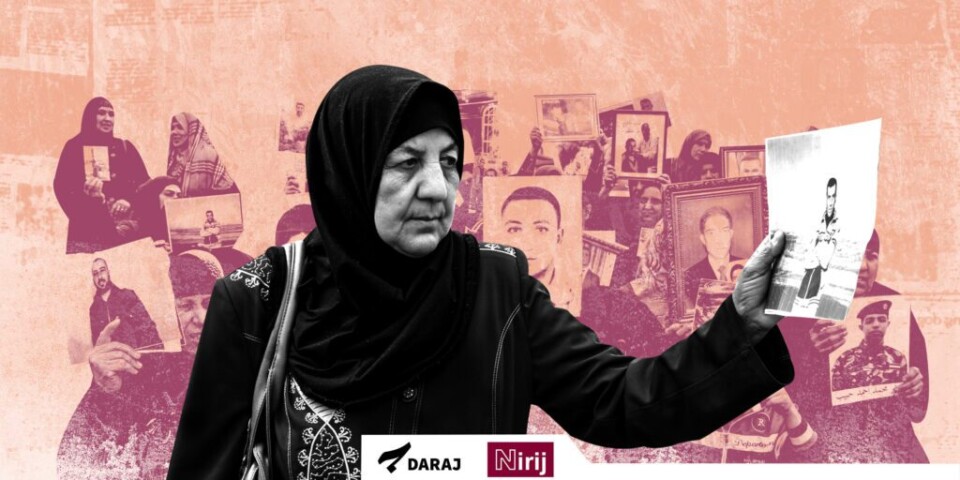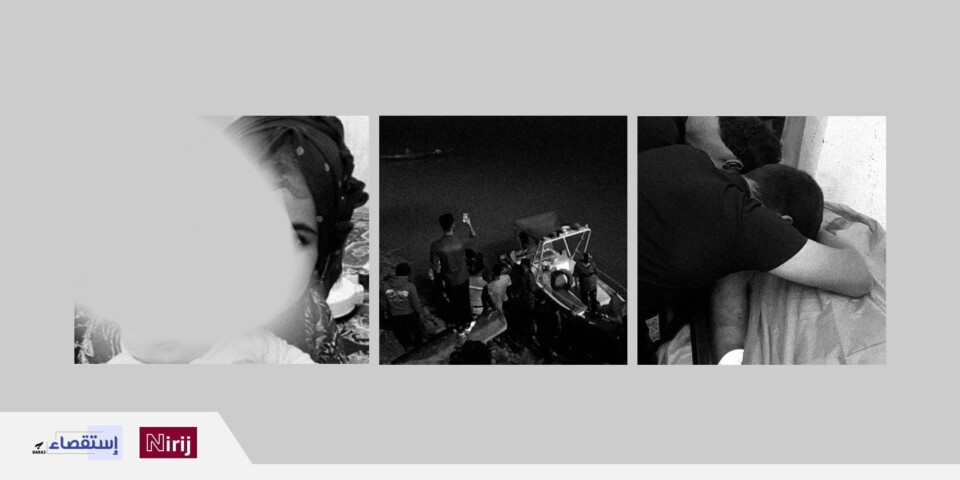

Nozat Shamdine – Translated by Walaa Rayya:
On the morning of July 24, 2014, the members of the Islamic State (Daesh) set up a perimeter around what is known as “Tal al-Tawbah”, on which the Prophet Yunus Mosque is built, on the left side of the city of Mosul, 405 km north of the Iraqi capital, Baghdad.
They moved out the inhabitants of the small houses in the back and stopped vehicular and pedestrian traffic in the streets around the hill. There was an atmosphere of anxiety and expectation. Just before midday, a loud explosion turned the mosque’s building into a gigantic ball of smoke and dust, which slowly cleared away, revealing the rubble of a building, some parts of which are about a thousand years old.
Thus, the group started to take control over the city of Mosul, the center of Nineveh Governorate, with an organized campaign of destruction of archaeological sites, that ended up with the destruction of 360 historical and religious monuments according to the Inspectorate of Antiquities and the Sunni Endowment Office in Nineveh.
It was the destruction of sites where “sinners are committed and worship is done for other than God,” as claimed by ISIS in its published statements, but in essence, it concealed large-scale thefts of artifacts and their sale through smuggling networks.
During the period of ISIS rule, which lasted for more than three years, hundreds out of 1600 archaeological sites were exhumed and looted. In addition, about 1,000 pieces that were in the Mosul Civilization Museum were stolen and the ones that cannot be moved from it were destroyed.
Four years after the end of ISIS control over Mosul, only 100 pieces of artifacts have been recovered, while some of the archaeological monuments were slowly restored and others were left due to their destruction. Meanwhile, the violations against the Nineveh monuments including the thefts, continue with the knowledge of the security and civil state agencies.
Dr. Muntasir Ghaleb Murad, a civil law specialist, says The Iraqi Antiquities and Heritage Law of 2008 includes articles that punish the theft of antiquities and those who exceed them with penalties ranging from several years to life imprisonment and, in some cases, execution.
“We know that citizens, armed outlaw factions, and even government agencies are involved in encroaching on the Nineveh monuments while the state authority is in an inaction, and they are all subject to penalties.”
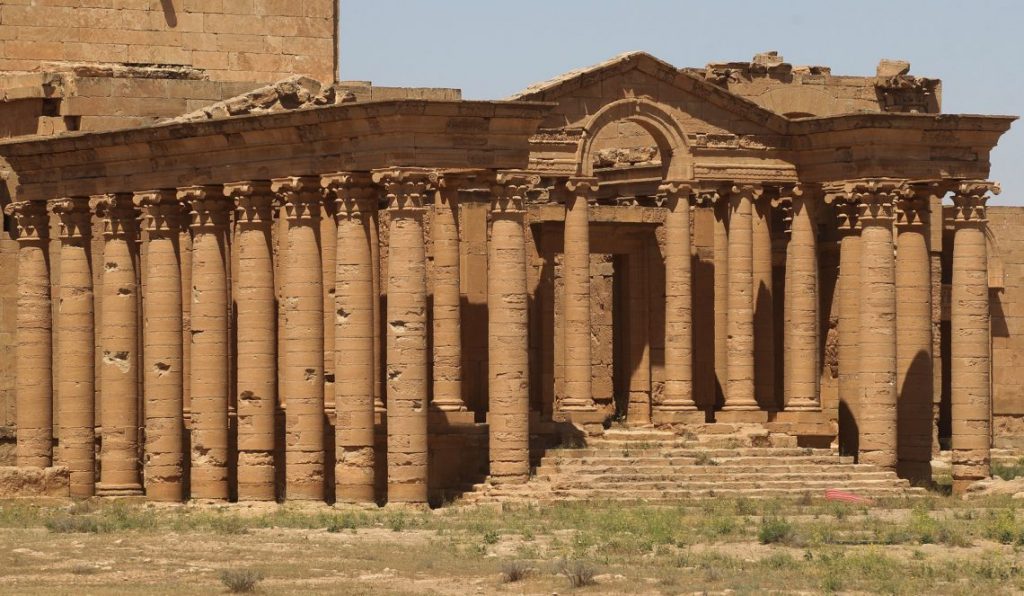
A long list of sites
After taking over Mosul on June 10, 2014, ISIS formed committees through ” Diwan Al-Rakaz” ( the department of resources) to count the number of historical or religious archaeological sites of apostate Muslims, Christians, Yazidis, and Kaka’is, in preparation for their destruction with an ideological excuse that Friday preachers loyal to ISIS used to repeat in the city’s mosques constantly, “it is idolatrous as it demands allegiance apart from God”.
The ISIS campaign began on July 19, 2014, and was prefaced by raising the statue of the poet Abu Tammam, which was standing on the right bank of the Tigris River in the heart of Mosul.
And then they removed the statue of Mullah Othman Al-Mawsili, the most famous musician and maqam reader in the history of the city (1854 – 1923), and it was standing near the train station. After that, they raised the rest of the statues and monuments, including the statues of Al Sawas and the spring girl.
Also on the ninth of June, the shrine, known as “The Tomb of the Girl” located on the center of the public street in the Ras Al-Jada area on the right side of the city of Mosul, was swept away. This shrine, originally the shrine of Islamic Historian Ibn al-Athir, is from 1232 AD.
The demolition and the bulldozing operations also included mosques with shrines, such as the shrine of Sheikh Al-Shatt (1168 AD) in the Al-Shahwan area and Sheikh Fathi (Al-Fath bin Othman Al-Azdi – 835 AD) located near the Fifth Bridge on the right bank of the Tigris River.
ISIS members blew up the shrine of Imam Yahya Abu al-Qasim (1240 AD), located in al-Shifaa area. And on July 23, 2014, they blew up the shrine of the Prophet Daniel in Hadira Al-Sada area, the Mosque of the Prophet Zarjis in the Al-Shaareen market, and the Mosque of the Prophet Sheet in the street of the same name.
The bombing included the shrine of Imam Awn al-Din (1248 AD) in Bab Lagash on the right side of Mosul, the shrine of Kadib Al-Ban Al-Azdi (1150 AD) in the Bab Sinjar area, the shrine of Sayyida Zainab (1221 AD) in the Sinjar district, west of Mosul, as well as the ancient city’s lighthouse, and the historic citadel in Tal Afar district, west of Mosul.
The last archaeological site that ISIS destroyed was the Al-Nuri Mosque, known as the Great Mosque on the right side of Mosul, where the ancient Al-Hadba lighthouse (1180 AD) is located. In that same place, ISIS’s leader, Abu Bakr al-Baghdadi, appeared in July 2014, announcing the establishment of the Islamic state in the regions controlled by his group.
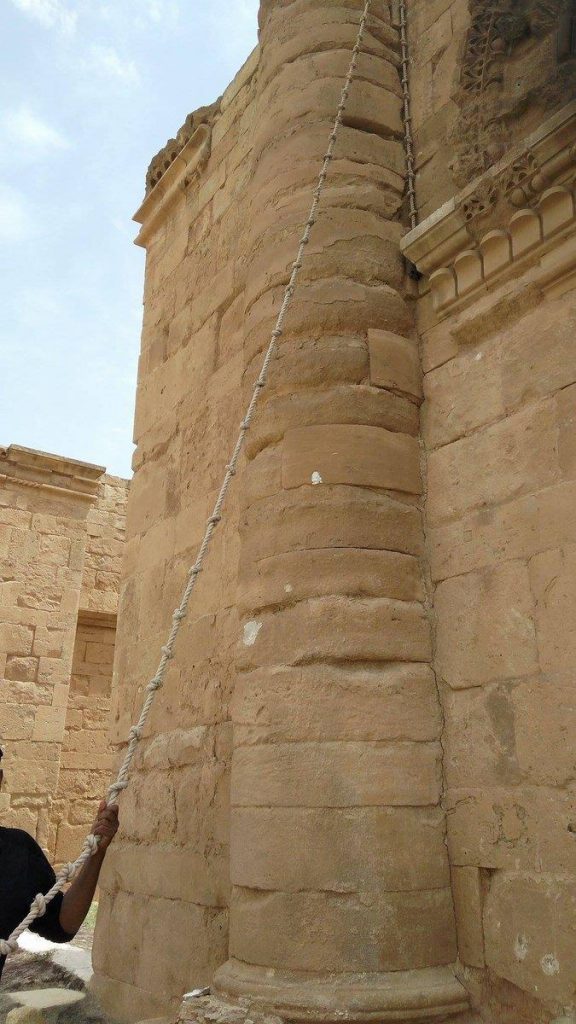
Faith or Money
Within a few months, “all the antiquities of Nineveh, whether in archaeological sites such as Hatra, Nimrud, Nineveh, Khorsbad, as well as those in the museum and places of worship, became a target of destruction, theft, and smuggling, as planned by the group who relied largely during that period on imports of antiquities smuggling as well as the imports of oil from the southern and western Nineveh fields.”
Researcher Adel Kamal says that the Diwan of Al-Rakaz (Department of (Natural) Resources) bears the responsibility, which underscored “the group’s reliance on antiquities as a financial resource because Al-Raqaz is an Islamic system related to what is buried underground and has a value other than minerals.”
He points out that the group ceremonially blew up the Prophet Yunus Mosque, which, according to what the people of the city believed for centuries, included the shrine of the Prophet Yunus. ISIS members justified it by the hadiths of the Prophet Muhammad saying that he forbade burial of the dead in mosques.
However, in fact, according to Kamal and other researchers, it’s about “the presence of an archaeological palace on the site that belongs to the Assyrian king Esarhaddon 680-669 BC, the group cleared itself of the accusation of demolishing the mosque without a legitimate excuse by blowing up the mosque to remove the shrine built on an ancient hill, and the palace’s priceless treasures became in its possession.
Adel Kamal explains that the group was able to remove the shrine without the need to blow the mosque with explosives and turn it into rubble!
ISIS removed 90% of the capital of the Assyrian Empire
The Prophet Yunus Mosque is located on the western side of Tel al-Tawbah, the main street that separates it from the beginning of another hill known as (Tell Quinjaq), which is a landfill located on top of the wall of the ancient city of Nineveh, where archaeologists date the first settlement to 6000 BC.
By 2000 BC the city became a center for the worship of the goddess Ishtar and then it became the capital of the Assyrian Empire that ruled the “four sides”.
The researcher and specialist in antiquities and heritage affairs, Dr. Yunus Salim Ahmed accompanied us during our wandering around the fence. He confirmed that the original wall of the Nineveh archaeological site was buried under the prominent hill, his length was 12 km, it surrounded the land that included the capital of the Assyrian state, there are only the ruins of the library of the Assyrian King Sennacherib left in there.
He mentioned that the seen parts of the wall were built in the early 1960s by a specialized Italian company that transported the wall’s stones from a quarry in the Sheikhan district (47 km north of Mosul), which is the same place from which the Assyrians had brought the stones of the original wall.
He said with dismay on his face, “shortly before the start of the Nineveh liberation operations in mid-2016, the members of the group carried out a campaign to demolish and bulldoze the gates of the ancient city of Nineveh, which dates back to (700 BC). They knew that the gates were original, so they swept them away and left the non-original parts of the fence intact.”
He tells us the details of what happened as we moved between the sites of the removed gates: “They first began to demolish the gate (Nergal), which was named after the Assyrian god “Nergal”. There were two large, winged eruptions in its entrance, they smashed it with pickaxes before the bulldozers demolished the gate and its surroundings.”
Then they destroyed the “Mashki” gate, which is popularly known as the (Al-Masqi gate), and (Adad) gate, which has the name of the Assyrian god Adad, and (Shamash) gate on the eastern side of the wall, finally, they destroyed Halsey Gate in the southern part of the eastern wall of Nineveh.
He pointed out that those four archaeological gates are what was left of the fifteen gates of the wall: Khatia, Kwai, Sahara, Armory, Khanduri, Ashur, Halzi, Kar-Melissa, Mochlo, Shepanibia, and Halaha.
According to Dr. Younis, the group carried out excavations in the ancient city of Nineveh under tight security. He said that according to eyewitnesses he knows the work focused on the “Tel Qinjouk” area, across the agricultural neighborhood on the left side of the city of Mosul. It is in the same area where an archaeological research team found four decades ago Sanjarib’s library, the oldest archaeological library, which included about 30,000 manuscripts.
The site remained subject to further excavation, but due to Iraq – Iran war (1980-1988), the excavation was postponed. “However, ISIS recently removed about 90% of the archaeological remains of Nineveh,” says Dr. Younis looking at the remains of the rubble of one of the gates.
The destruction of the ancient Nimrud in three stages
In April 2015, the group published a video clip showing its members in the ancient city of Nimrud (30 km southeast of Mosul) beheading winged bulls and carvings dating back to the Assyrian era.
They used saws, electric drills, and big demolition hammers. Then they blew the site up, which was for nearly a century and a half the capital of the Assyrian state, claiming that it was a polytheistic site, according to what was mentioned in that clip.
The ancient Nimrud, known as (Kalho), was the royal residence of King Ashur Nasirpal II and capital of the Assyrian state in the thirteenth century BC. It was nominated for the list of the World Heritage Organization of the United Nations Educational, Scientific and Cultural Organization “UNESCO”.
Archaeologist Majed Saeed, standing amidst piles of stones that formed a temple, expressed his hopes that palaces, temples, and ziggurats would be restored with international cooperation so that they could be included in the World Heritage List.
He added pointing to the western side: “There were the halls of the royal pavilion or the performance of religious rites, and they were decorated with marble panels and sculptures representing King Ashur Nasir-Pal II, wearing his official clothes, holding in one hand a cup of holy water and in the other an arch, and on his both sides there were two winged angels their right hand was raised to bless the king.”
Then he pointed to the eastern side, where the remains of a wall: “On this wall, there was another marble sculpture of two-winged angels with the heads of a falcon and an eagle, which ISIS elements smashed with hammers as they did with the rest of the carved murals.”
Why were they cutting it with saws?
Near a newly installed “BRC” wall to prevent the theft of bricks from the ruins of Nimrud, the archaeologist Majed was a little bit nervous and he said “Two winged eruptions were guarding that entrance. ISIS members as was shown in the video published in 2015 were sawing their heads and the rest of the parts.”
Then he asked: “If they aimed to destroy the statues, why did they break them into square pieces, why didn’t they destroy them with big hammers as they did with the rest of the parts?”
He believed that they cut these parts in this way to facilitate the process of transporting the pieces, then smuggling them to sell them, it’s the same way they used with the pieces they stole from the Mosul Museum, Esarhaddon Palace, and the city of Nineveh.
He added: “ISIS destroyed the ancient city of Nimrud in three stages, the first started on March 12, 2015, and targeted the front façade of the palace that was bulldozed, along with collecting artifacts and transporting them by trucks to an unknown location. In the second stage, they blew up the first gate completely.”
In the third stage, “The group used explosive drums targeting the entire site, and the detonation caused great havoc.”
Then he pointed to the place he was standing on: ” there was a small house standing here, inhabited by the British novelist Agatha Christie in 1930 while she accompanied her husband the scientist Max Mallowan in his archaeological explorations here at the beginning of the last century.”
He added, after a moment of silence: “The authorities of the former Iraqi regime removed it with its furniture in 2000, and ISIS would certainly have done the same if it had had it!”
Musab Muhammad Jassim, the former director of Nineveh Antiquities and Heritage, said that 90% of the city of Nimrud was destroyed, and according to our information, the group destroyed the city’s halls and large walls with ordinary demolition tools and then detonated them after stealing what its members could carry.
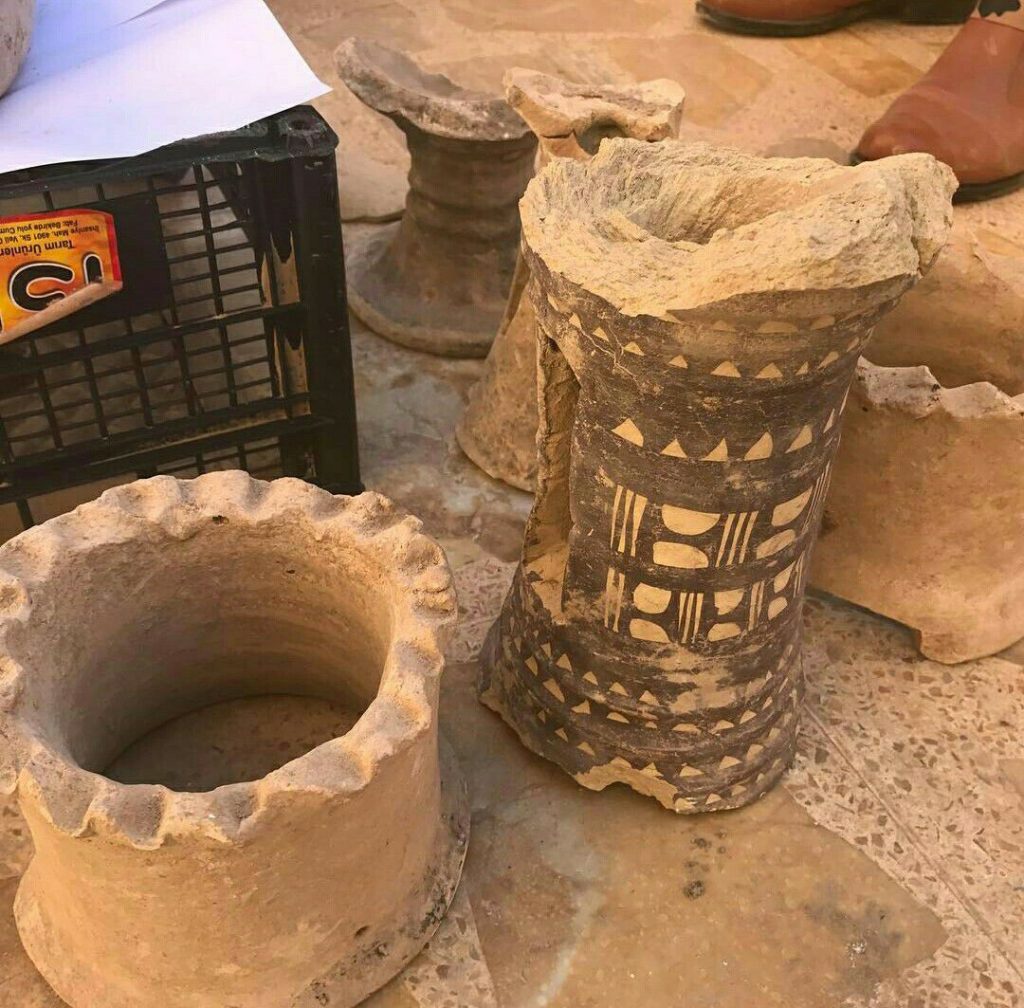
Hatra is the biggest survivor of the destruction
The Kingdom of Hatra is located southwest of the city of Mosul (80 km). It is also called the Kingdom of Arabaya, as it represents the oldest Arab kingdom in Iraq. It appeared in the third century AD and was ruled by four kings and their reign lasted almost a hundred years.
A source in the Nineveh Antiquities Inspectorate, in response to our question about the damage caused to Hatra, said that ISIS had used its temples and palaces as a training camp for its members, and its statues and marks for shooting, but the damage is very slight compared to what happened to Nimrud and Nineveh.
According to the source, joint work was undertaken with the support of the international foundation ALIPH, in cooperation with an Italian organization, The International Association for Mediterranean and Oriental Studies (ISMEO), to rehabilitate the management headquarters of the Hatra archaeological site in preparation for the start of maintenance and rehabilitation work.
A journalist who works as a correspondent for a foreign agency in Mosul and covered the battles of the Nineveh Restoration said that he received a phone call in April 2017 from the Popular Mobilization Forces, to accompany his members that will free the Hatra archaeological area.
He said that the one who invited him and his colleagues to go to Hatra was the leader of the Popular Mobilization at the time, Abu Mahdi Al-Muhandis (Abu Mahdi Al-Muhandis was killed along with Qassem Soleimani, the head of Iran’s elite Quds Force, and a number of their companions by the US via a drone strike that targeted them as they were leaving Baghdad International Airport on January 3, 2020).
The journalist, who requested to not mention his name, says that after the liberation of the archaeological site he heard the engineer saying that the journalists were invited to document the site “so that the Popular Mobilization Forces would not be accused of destroying Nineveh’s monuments, as happened in other sites during the liberation war from ISIS.”

Recovery of 10% of missing pieces of Mosul Museum
Before the end of February 2015, the group published a video clip showing its members destroying statues and artifacts in the Mosul Museum, which is the second oldest museum in Iraq after the capital Museum in Baghdad, founded in 1952.
Unlike the previous times when the group showed similar clips, one of its members appeared without a veil and said that “the Islamic State in Iraq and the Levant is enforcing sharia rule over idolatry.”
A security source in Nineveh told us that after Mosul was liberated in 2017, the security forces arrested this person who called Yasser and is a resident of the eastern city of Mosul, but he refused to make any statements about Yasser’s confessions.
What was promoted about the destruction of all the artifacts in the museum wasn’t accurate. Atheel al-Nujaifi, the former governor of Nineveh (2009-2014), told us that the Mosul Museum of Civilization contained many artifacts before the war that toppled the former regime in April 2003, but the authorities transferred a large part of them to the National Museum in the capital, Baghdad.
The Mosul Museum replaced some of them with gypsum pieces similar to the transferred original, which ISIS elements were shown destroying in the video they shared during their control of Mosul.
Al-Nujaifi said: “Only two real pieces were destroyed, and they were a statue of a winged bull and a statue of the sun goddess. As for the rest, all of them were fake, which means that they stole the original one.”
An employee at the Mosul Museum confirmed it and said that the group only showed pictures and video clips of destroying some statues and pieces, most of them was fake and made of gypsum as compensation for those transferred to Baghdad or lost due to the looting that accompanied the fall of the former Iraqi regime in 2003.
He said that the group transferred the museum’s assets of statues of various sizes and shapes to an unknown destination. They were 173 pieces, in addition to hundreds of pottery pieces and manuscripts that were stored. He believed that they organize their transfer to sell them abroad.
He also explained that ISIS had looted the Mosul Museum of Civilization assets before publishing the video in February 2015. He thinks that the video was probably filmed in July, during the same time that the archeological mosques were destroyed. He justify it by saying that the ISIS members who appeared in the video were wearing summer clothes, while the weather in Mosul during February is rainy and cold.
He added: “They were publishing these videos to cover up the smuggling of antiquities out of the country through Syria. This is confirmed by the fact that they showed the fake pieces and not showing dozens of original pieces of different sizes representing various civilizations that prevailed in Nineveh over the past 5,000 years, including traces belonging to Islamic civilization. It is completely inconceivable that they destroyed the Islamic monuments in it. ”
The museum employee said that only 10% of the items stolen from the museum had been recovered. Since the liberation of Mosul, the security forces have seized about 100 pieces, most of them belonging to the museum. While ISIS’s members have stolen other pieces from other places (they likely took them during their excavations for antiquities). He admitted that his department did not have the necessary funds to count and classify the pieces.
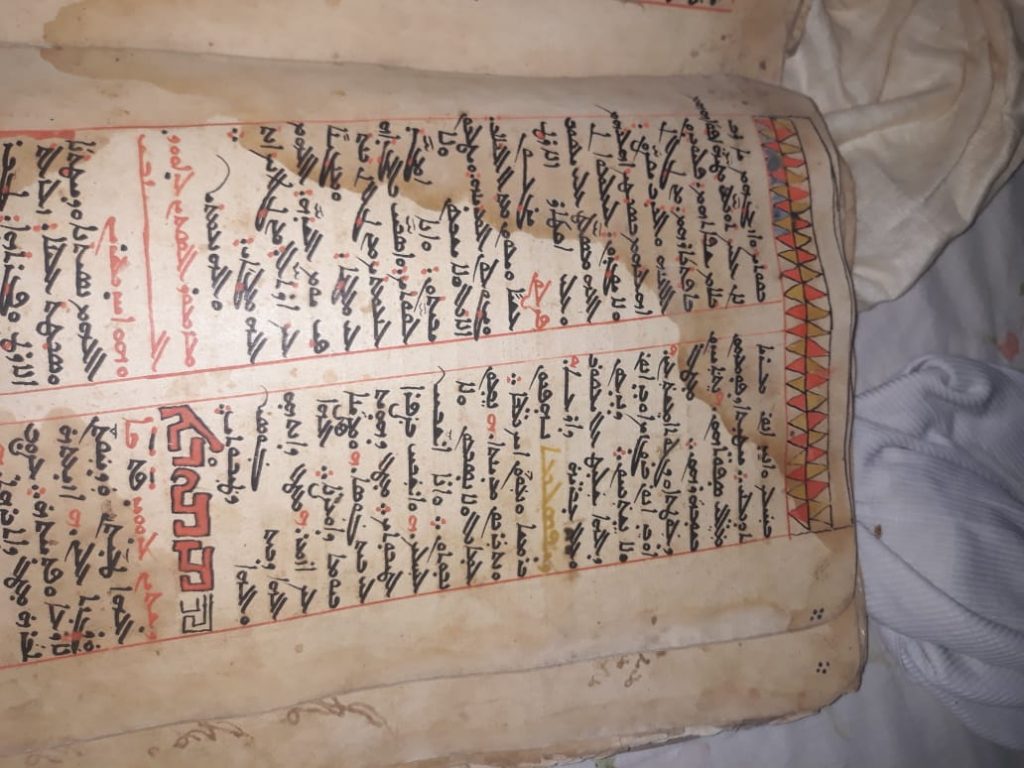
The systematic destruction of 300 mosques and 30 churches
During its control, the group published videos showing the demolition of mosques and shrines, along with a statement that included references to hadiths that forbade building graves inside mosques, to justify the demolition.
According to Abu Bakr Kanaan, the director of the Sunni Endowment in Nineveh, 300 monuments were destroyed by the group, most notably the mosque of the Prophet Yunus, the Prophets Shit, Gargis and Daniel mosques, as well as the Nouri mosque, the Sheikh Fathi shrine and Ibn Kathir shrine known in Mosul as the Tomb of the Girl.
Kanaan noted that his department had laid the foundation for the reconstruction of the Prophet Yunus Mosque in 2017, but the financial needs was an obstacle to its reconstruction in the short term which is the same obstacle to the reconstruction of other archaeological sites.
He also confirmed that the ideological destruction statements were just a cover for the looting of the assets of those sites, “since each site was guarded before and after the bombing by ISIS members who prevented people from approaching it for several days.”
On the right side of the city of Mosul, specifically in Souk al-Shaar’in in the old city, there were four churches in a small area known as (Hosh al-Bay’a), the Syriac Orthodox Church and the Armenian Orthodox church, and two Syriacs (Catholics) Churches called Al Tahira Church and Sayidat Al Intikal church, which was built eight centuries ago, according to the priest Raed Imad, the official of the Orthodox churches in the city.
The group used Hosh al-Bay’a after taking control over Mosul as an administrative headquarters and as a prison before it was destroyed in the Mosul liberation battles between 2016 and 2017.
Pope Francis held a Mass among the ruins of Hosh al-Bay’a on 7 March 2021 during his first visit to Iraq. Just days before, the service agencies in Mosul had paved a road with one lane on the ruins of the area to reach the place of the Mass. This provoked a wave of widespread local resentment because the road was extended within parts of an area that was occupied by the four neighboring churches (Hosh al-Bay’a), which constituted a violation of areas considered archaeological and of nominal religious value.
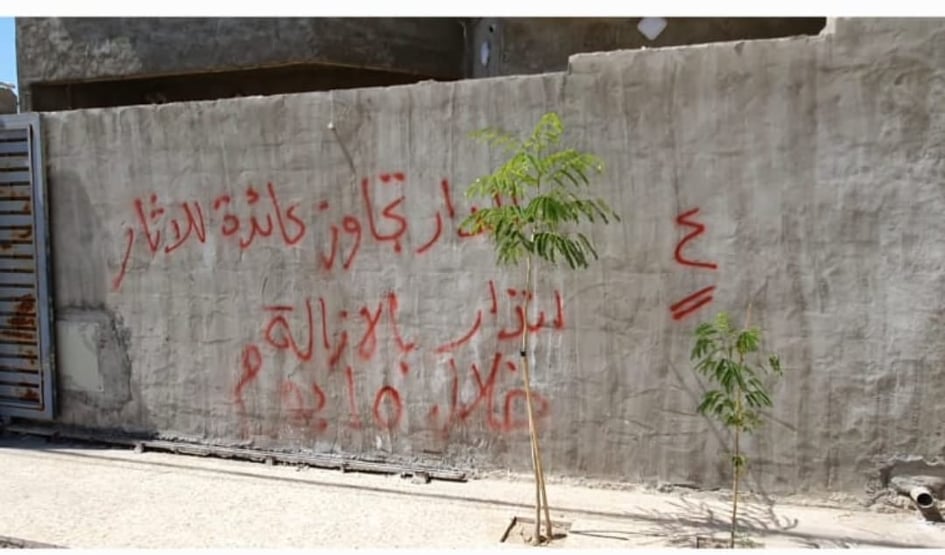
The priest Raed said that there are 30 other churches in Mosul, most of which are archaeological, that were looted and partially damaged or destroyed during ISIS rule of Mosul, including the Mar Isaiah church which was built 1200 years ago in the Ras al-Kur area of the old city, and The Shifa Church in the Shifa neighborhood and it is about a thousand years old.
ISIS members seized thousands of rare manuscripts and books that were in the libraries of these churches, as well as the assets of a museum belonging to the Syriac church in the Nineveh Plains. Those assets have disappeared and there is no trace of them in the remaining and destroyed churches.
The churches survived the successive bloody times of Mosul over 1770 years of Christian existence in it until they eventually fell into the hands of ISIS, and become legitimate courts of the group or prisons for the opponents. Crucifixes, drawings, and inscriptions were removed from them and anything that indicated that they were once churches were destroyed. Then the war of liberation came to turn them into rubble.
The Clock Church also known as The Our Lady of the Hour Church, the Wonder Mother, and the Dominican Fathers Church located in the center of Mosul, and built in 1873, was also destroyed. Its clock tower was still standing and hold a clock that Queen Eugenia, the wife of French Emperor Napoleon III, gave to the Dominican fathers as a reward for their efforts in providing treatment and distributing medicines and food to the people of Mosul after the typhoid disease had killed many of them between 1879 and 1880.
However, ISIS members destroyed it in a couple of hours, as an attempt to erase its symbolic value in the place that was known by its name “The Hour”. And they did the same thing with other archaeological sites and cities in Nineveh.
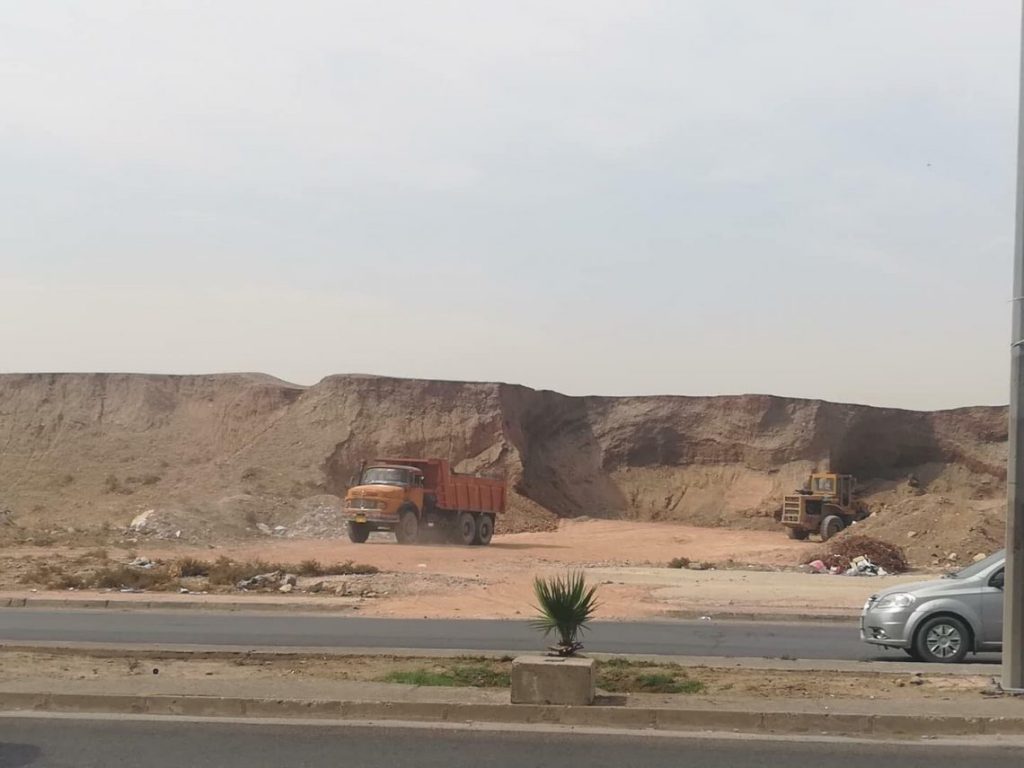
Al Hadbaa: Mosul’s symbol for eight centuries
The group ended its destructive parties just before losing its control of the city in the middle of 2017 by blowing up the lighthouse of the Nouri Mosque or The Grand Mosque. His mausoleum was well known and called Al Hadbaa Lighthouse, from which Mosul derived one of its many other names Al Hadbaa City.
This lighthouse, which was 45 meters high and inclined toward the east because it had been stuffed with render, was built by Nur ad-Din Zinke during the rule of Saif al-Din Ghazi II Ben Mudud of Mosul (1170-1180).
Its inclination made it famous so it became a symbol of Mosul for hundreds of years. Its bombing caused a major shock to the people that even exceeded the anguish of losing thousands of them killed by ISIS or during the war of liberation.
UNESCO laid the foundation stone for the reconstruction of the Al-Nouri Mosque and its lighthouse, according to a four-year plan called “the initiative to revive the spirit of Mosul’, with the support of the United Arab Emirates and a funding of 50 million dollars. A competition was launched for the best design of the Al-Nouri Mosque and Al-Hadbaa lighthouse.

Archaeological abuses with official permits!
According to the source of the Department of Antiquities and Heritage in Nineveh, to which we spoke, there are 1,600 archaeological sites in all regions of the province, 1064 of which are unprotected, only 536 sites have security protection, which means that violations of the antiquities of Nineveh will continue, especially in the invisible areas.
The excesses did not stop with the fall of ISIS control but continued with the presence of the Shia Popular Mobilization Forces, which took over the security file and dominated the ground in many areas after the end of the war of liberation from ISIS in 2017. A source from the Sunni Endowment Office in Nineveh confirms that there have been numerous abuses of the monuments with the direct or indirect support of these forces.
During the investigation process, we found many violations against the antiquities of Nineveh, some of which are carried out with official approvals from government agencies, and the Nineveh Antiquities and Heritage Inspectorate is involved in some of them.
The archaeological monuments located on the opposite side of the street parallel to the Nabi Yunus Mosque, specifically on the plot numbered 3/41 in the northern Nineveh Province, were registered in the name of the dissolved Ministry of Endowments and Religious Affairs and it was transferred to the administration of the Shiite Endowment Office supported by the Popular Mobilization. The land was leased to Uday Hussein Mohsen Al-Amara and became a flea market filled today with vendors and shoppers, even though it is an archaeological site.
There were excesses on three adjacent hills called (Tulul Majarin), located about 20 km west of the city of Mosul, and they are one of the well-known archaeological sites where excavations stopped decades ago due to the war and its repercussions.
Two citizens from the nearby village of Twaim told us that members of Popular Mobilization Forces have excavated monuments in the area for days, under the pretext of uncovering what is currently known as the” Sabaya (Captives) Road”, but in fact, they were stealing antiquities in broad daylight and with the knowledge of the regular security services stationed close to the region”.
There is an active committee known as “The Committee for Exploring the Road of the Captives” in western Nineveh, this road has a relation with a historical event that the Shiites revive annually: the Battle of Karbala which was fought in 680 between the army of the second Umayyad Caliph Yazid I and the army led by Husayn ibn Ali, the grandson of the Islamic prophet Muhammad, at Karbala, and lasted for 3 days.
The project of Committee for Exploring the Road of the Captives, according to the Shiite Endowment, aims to determine the road taken by the caravans of the forces of Yazid bin Muawiyah who captured the women of the family of the prophet.

There were violations of the archeological areas in the ancient city of Nineveh, some of them with the knowledge and approval of government departments, including the Nineveh Antiquities and Heritage Inspectorate.
The two brothers (Khair Al-Din and Saud Hassan Al-Omari) regained, under a court judgment on December 31, 2008, the ownership of their land located on the street passing from the western side of the ancient Nineveh Wall (Nergal), the land had been confiscated by the former Iraqi regime according to their claim in the court. In mid-2021, they obtained a definitive decision to recover the land on which the Mosul Municipality constructed another street within the sites of the ancient wall, in violation of the official instructions that set the antiquities site as a protected area within a border of 30 meters.
The two brothers will remove the old street and divide the land into pieces in preparation for its investment. This has reinforced the fears of observers, that the creation of buildings in the place will lead to minimizing the zone included in the archaeological fence, which constitutes a violation of the instructions of UNESCO.
It’s only been a few days since the problem of the western side of the fence until a wave of anger swept across Mosul, following the announcement of a decision by the Nineveh Antiquity and Heritage Inspectorate on 15 July 2000 to remove 160 houses built on antiquity taboos along the northern side of the Nineveh Wall near the neighborhood of Muthanna. The owners were given two weeks to evacuate it.
Eight types of destruction
During our investigation of the monuments of Nineveh, we observed that it was exposed to eight types of serious abuses, which are:
Explosions carried out by ISIS that led to total or partial destruction, bulldozing operations carried out by ISIS and the municipality of Mosul, creating a building to hide the features of an old building, as the organization did when it blew up the shrine of Imam Yahya bin al-Qasim in Mosul, and built a mosque in its place, destroying the land to invest it, as ISIS did by destroying the collectors of the Prophets Sheet and Zarzis and created two parking lots on the land and obtained their revenues. The same thing was done by the Shiite endowment office in the land near the Prophet Yunus Mosque, which is a protected antiquities site, that he rented to sellers of used clothes and others. Partial destruction of a shrine, a mosque, or a church, or inscriptions in a mosque, a church, or an archaeological or heritage house.
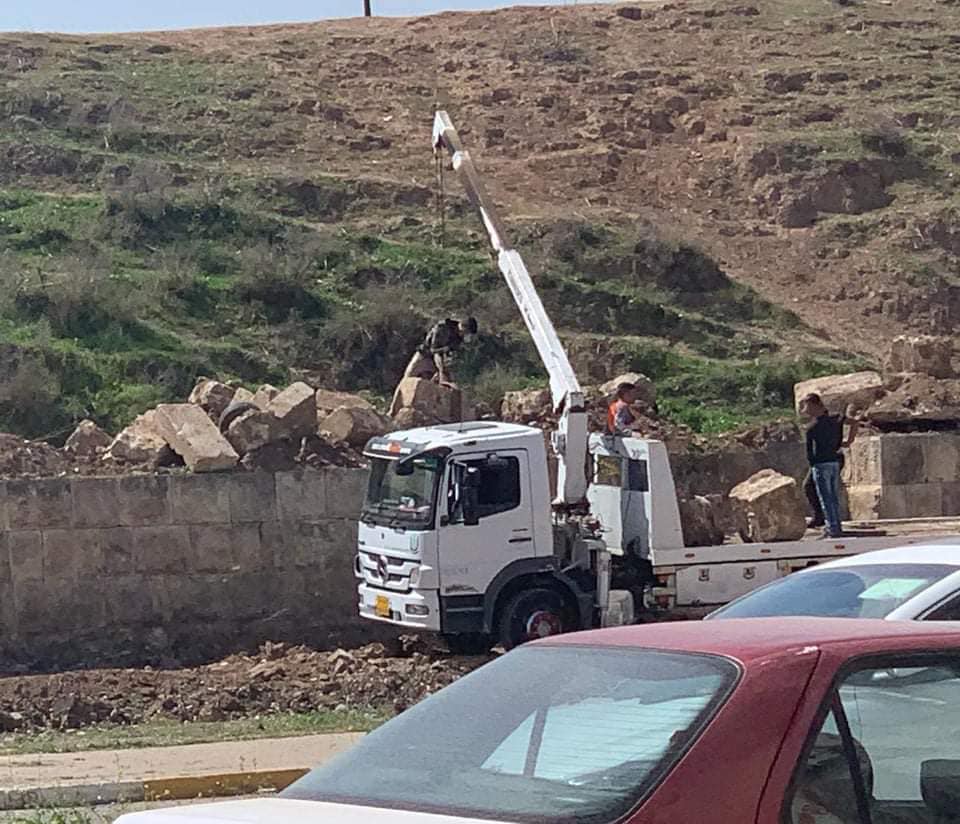
The abuses also include destruction with chemical materials that aimed to remove all traces of the facility or building, which ISIS did in many locations, one of them was a temple in the city of Hatra. And the use of explosive devices called (the ruler), as the group did in the ancient city of Nimrud, and the security forces are still finding some of it.
The last abuse is the destruction resulted of digging tunnels under archaeological sites, as ISIS did in the Esarhaddon Palace under the Prophet Yunus Mosque, either for excavating for antiquities or monitoring and hiding, as is the case in the “Tal al-Rasm” area in Makhmour district, east of Mosul where ISIS members made a sort of runway on the archaeological hill.
The report was produced with the support of NAWA IF
https://ar.nawamedia.org/nawa-investigative-fund/
Investigative Reports
Investigative Reports","field":"name"}],"number":"1","meta_query":[[]],"paged":1,"original_offset":0,"object_ids":21663}" data-page="1" data-max-pages="1">






